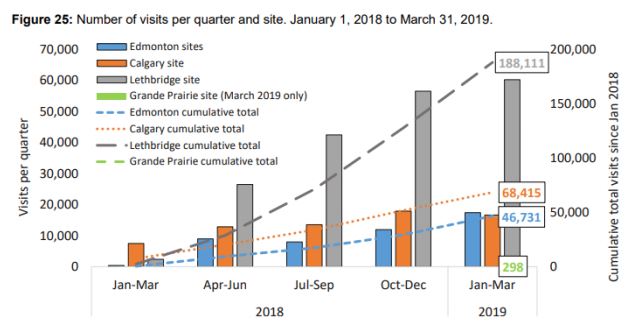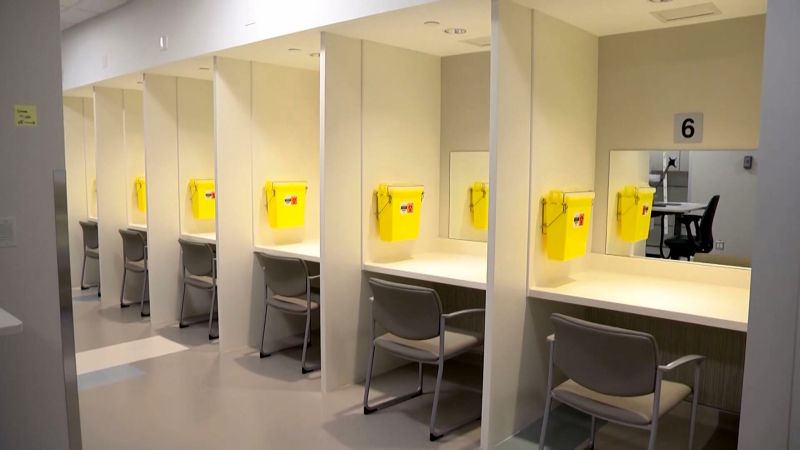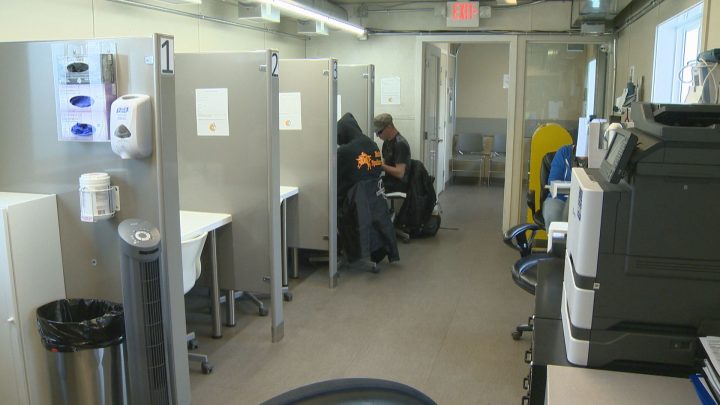Alberta’s supervised consumption and overdose prevention sites have a 100 per cent success rate, according to a new community-based report, and have saved the lives of more than 4,000 people since 2016.

The report from the Alberta Community Council on HIV (ACCH) suggests 300,000 people have visited Alberta’s six supervised consumption sites — three in Edmonton and one each in Calgary, Lethbridge and Grande Prairie — and that none of those people have died while using the services since they’ve opened. The consumption sites at the Royal Alexandra Hospital and Drumheller Correctional Facility were not included in the report.
The report also credits staff at the supervised consumption sites — and the one overdose prevention site in Red Deer — with reversing 4,305 overdoses as of May 2019, which is 100 per cent of the overdoses that have happened.
The majority of those overdose reversals — 2,102 — happened in Lethbridge since that centre opened in February 2018.
Calgary’s downtown site reversed 1,055 overdoses between its opening in November 2017 and May 2019. Staff at Edmonton’s sites reversed 627 overdoses between them since March 2018 and the Red Deer overdose prevention site saw 481 reversals since it opened in October 2018. Grande Prairie’s supervised consumption site staff reversed 40 overdoses between March and May 2019.

The report says the presence of supervised consumption sites in Alberta cities has lightened the load on emergency services: 3,709 calls to EMS were averted because of the sites and various infections, from HIV and Hepatitis C to syphilis and gonorrhea, were prevented or reduced. More than 10,000 people have also been referred to addiction and treatment services.
“I think what I’m really hoping is that they remember that there are two sides to this issue,” ACCH executive director Celeste Hayward said Wednesday.
“There’s the impact on local businesses and the community but there’s also the other side where it saves lives — it connects people to essential services. There is a way to balance that.”

Get weekly health news
Hayward said the various organizations that operate the supervised consumption sites do a lot of work to address the impacts and negative situations that arise around the sites.
“We need to pull back from a micro-focus on supervised consumption sites and instead, see it as part of a large network of services that are needed in the community,” she said.
“People didn’t start using substances because a [supervised consumption site] came into existence. It was already there. It was already happening.”
The report says about two people per day die from overdoses outside the supervised consumption sites in Alberta, adding 2,183 died between January 2016 and March 2019 — 79 per cent of which were accidental fentanyl overdoses.
Provincial funding freeze
Demand for safe consumption services has increased over time in Alberta, according to the report, and the province has recently seen a 24 per cent decline in fentanyl deaths, suggesting the harm reduction initiatives are working and expanding them should be a priority.
Funding for Alberta’s supervised consumption sites has been frozen while the government conducts a review.
According to Steve Buick, spokesperson for the Minister of Health, the panel conducting the review will focus on the socio-economic impacts the sites have on the areas in which they’re located, in terms of safety and crime. He added that the government isn’t ignoring the impacts sites are having on harm reduction.
WATCH: Alberta supervised consumption site review: Associate minister responds to critics, outlines plan

Hayward said she’s not surprised by the government’s decision to launch a review, but said the makeup of the panel is narrow in its specializations and perspectives, which is concerning.
“I’m concerned that the loudest, angriest voice is going to be listened to, which doesn’t necessarily make them right,” Hayward said.
“There is a place for us in the community and we need to make that space — these are human beings we’re talking about.”
The ACCH launched the review after being asked by supervised consumption site agencies in May to compile a report. It used information and data from public reports including quarterly Alberta opioid surveillance reports, medical examiner’s reviews, the report into crime and disorder near Calgary’s Sheldon Chumir site, and internal data from the sites themselves.
Hayward said the report was not in response to the review panel, rather the timing was a coincidence. She said the ACCH has applied through the AHS website to have the report presented to the panel and also sent it to Premier Jason Kenney and the health ministry.
Overdose prevention VS supervised consumption sites
According to Alberta Health Services, the Red Deer overdose prevention site differs from the supervised consumption sites across the province in a number of ways, including the fact that the current site is temporary and put in place to assess “an urgent health need.” It’s to monitor people who use previously-obtained drugs and to watch for adverse events like overdoses.
Supervised consumption sites offer those services, along with more robust resources like counselling, social work and opioid-dependency treatment. Getting approval for a long-term supervised consumption site is also a more robust, federal process than that for an overdose prevention site.

Hayward said it was important to include the Red Deer site in the data collection because it’s essentially doing the same work as a supervised consumption site, but it’s doing so without full-time funding and a solid future.
“It was supposed to be a measure to bridge the gap while they were getting everything underway for a permanent site,” Hayward said, adding that the permanent site is now on hold due to the freeze.
According to AHS, Red Deer has the highest rate per capita of fentanyl-related deaths in the province, and the organization operating the overdose prevention site, Turning Point, is working to establish a permanent supervised consumption site after receiving municipal approval from the City of Red Deer.







Comments